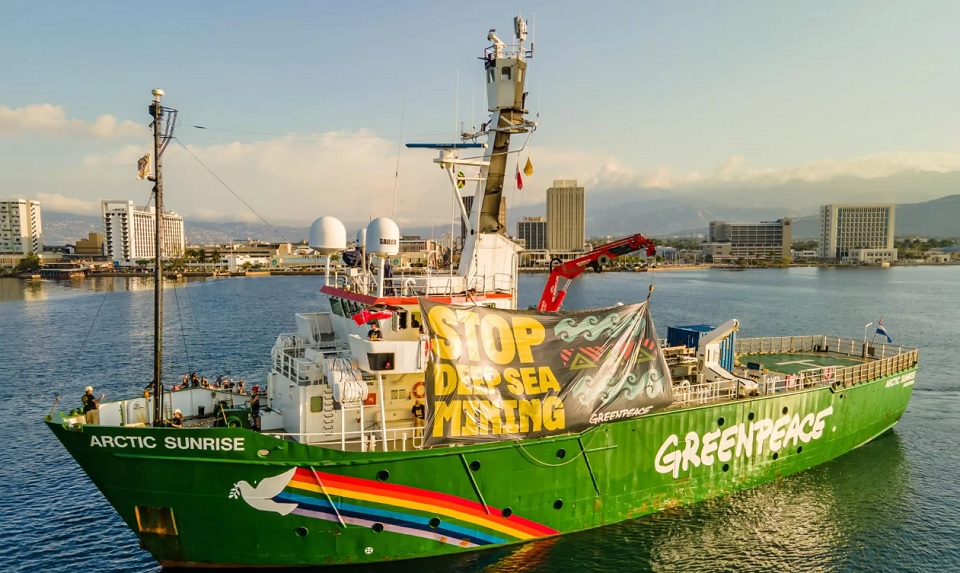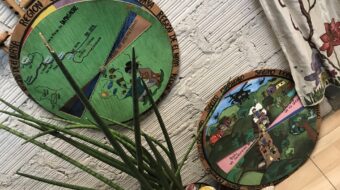
This week in Kingston, Jamaica, the United Nations’ International Seabed Authority (ISA) is conducting a second week of negotiations that could shape the future of the deep ocean.
In 2021, the Pacific nation of Nauru triggered something called the two-year rule, which gives the ISA until July 9 to establish regulations to govern the controversial practice of deep-sea mining. This 28th session, which launched March 16 and concludes Friday, is the body’s penultimate meeting before that deadline.
“The ocean is at stake,” University of California, Santa Barbara deep-sea biologist Dr. Diva Amon, who is representing the Deep Ocean Stewardship Initiative in Kingston, told EcoWatch.
But beyond the looming threat of commercial mining, something else was different about these negotiations. Influential civil society groups including Greenpeace, the Deep Sea Conservation Coalition, the Pew Charitable Trusts and WWF have given up their seats to a large coalition of Indigenous Pacific activists who have come to share their vision of the high seas, a vision that contrasts the nationalist perspective that they are “nobody’s land.”
“What we want to express is that we don’t view this as nobody’s land because it is part of our country,” Hawaiian Indigenous speaker and activist Solomon Kaho’ohalahala told EcoWatch. “This is where we have lived and thrived and have inhabited the largest area of ocean and islands on planet Earth.”
“Part of our country”
Kaho’ohalahala hails from the Hawaiian island of Lānaʻi, where he has worked to establish marine conservation areas and to protect the native dryland forest. He has also joined efforts to protect Hawaiian marine biodiversity as a whole as part of the Maui Nui Makkai network and the
Native Hawaiian Cultural Working Group that championed the expansion of Papahānaumokuākea Marine National Monument into the world’s largest Marine Protected Area under then-President Barack Obama. In addition to his advocacy against deep-sea mining, he is also now campaigning for the expansion of the Pacific and Remote Islands National Monument, which President Joe Biden recently told the Secretary of Commerce to explore.
Now, he has traveled to the ISA negotiations with other Pacific activists onboard the Greenpeace ship Arctic Sunrise. On March 20, he joined more than 1,000 Indigenous people from 34 countries and 56 communities in signing a petition to the ISA calling for a ban on deep-sea mining. As the advocates presented the petition, he offered a traditional chant for ISA delegates called an Oli.
At a discussion on underwater cultural heritage two days later, he told a story explaining his people’s relationship with the ocean.
“From a Native Hawaiian perspective we have a story that is partly our genealogy and it’s called the Kumulipo,” Kaho’ohalahala told EcoWatch.
This creation story tells how Kumolipo, the first male, and Poele, the first female, gave birth to the first living creature in the deep sea: the coral polyp.
“From there all other things evolve and are created,” Kaho’ohalahala said. “So from the deep sea to the nearshore waters, into the land, into the mountains and then even taking flight and even into the heavens above.”
This includes the Hawaiian people who, once they arrive on “Island Earth,” are tasked with caring for their ancestors, including the coral polyp or “first grandparent,” he added.
This is a radically different view of the ocean from the exploitative, nationalistic model that gives rise to ideas like deep-sea mining.
“It’s been a game changer,” Greenpeace USA senior oceans campaigner Arlo Hemphill said of the Indigenous presence at negotiations.
One aspect that perspectives like Kaho’ohalahala’s have revolutionized is the concept of cultural heritage, which most nations thought of as shipwrecks from famous battles or swallowed villages and not the shared genealogy with the non-human world represented by the Kumulipo. It’s a worldview that ISA delegates have welcomed, however. The ISA’s new cultural heritage working group invited Kaho’ohalahala to join, and the ISA is considering creating an Indigenous forum.
“This has set off a new dialogue in the ISA that’s never existed before,” Hemphill said.
“A new sail plan” for the Clarion-Clipperton Zone
One of Kaho’ohalahala’s leading concerns is that when Narua triggered the two-year rule on behalf of Nauru Ocean Resources Inc (NORI) – a subsidiary of a Canadian company The Metals Company – the place it pin-pointed for mining was the Clarion-Clipperton Zone (CCZ) between Hawaii and Mexico.
“It is quite clear to me that if we say nothing then we have done nothing to preserve our own cultural heritage and our genealogy that describes who we are and where we are and where we come from,” Kaho’ohalahala said.
Stretching for 3,100 miles, the CCZ is home to unique deep-ocean ecosystems whose particularity makes them especially vulnerable to the mining that might take place there. Between 70 to 90 percent of the species scientists have found there were previously unknown to them, Amon said, while 25 to 75 percent have yet to be observed at all. At the bottom of the seafloor there is mostly shifting sediment, so more than 50 percent of deep-sea animals larger than one centimeter that call it home – animals like sponges, anemones, or corals – use the nodules scattered about as a stable surface to attach to. This is a problem because it is exactly these nodules that corporations like The Metals Company want to mine for copper, nickel, cobalt, iron, manganese, and rare earth elements.
“Without the presence of the nodules, the ecosystem will not function in the way it once did,” Amon said. “It will be severely compromised.”
Another concern about deep-sea mining is the plumes of sediment it will release into the ocean. This would threaten the CCZ in particular because, for much of the zone, particulate matter rarely travels between the seafloor and the surface, leading to “incredibly crystal clear waters in the deep ocean,” Amon said. The ancient ecosystems of the CCZ have evolved to thrive in this clarity. Who knows how they would manage in murkier waters?
“There’s a lot of concern about the fragility and vulnerability of the Clarion Clipperton Zone and its ability to recover from these impacts,” Amon said.
Kaho’ohalahala is also worried about the increased turbidity in the water that will result from dredging the deep sea and releasing some of that material into the water column.
“Our pelagics and all of the phytoplanktons and the zooplankton that are part of the water column are definitely all going to be impacted, and then the food chain in itself is going to be impacted. And if that is the case, then perhaps even the ability for us to subsist and sustain our life in our country, the ocean is now being threatened,” he said.
That is why he is sharing a different view of the ocean, one that emphasizes the long-term benefits of protecting it for everyone rather than permanently destroying habitats for short-term mining profits.
“I want to propose a new sail plan with a new horizon,” he said.
Lessons from Aotearoa
Another Pacific advocate who traveled to Kingston with Greenpeace is Phil McCabe of Aotearoa / New Zealand, who is part of the Deep Sea Conservation Coalition.
“I’m a lifelong lover of the ocean,” McCabe told EcoWatch in an email. “As a surfer and a coastal resident, my community revolves around our local marine environment.”
McCabe is also a veteran of the fight against deep-sea mining in his home country, serving as the Chairperson of Kiwis Against Seabed Mining (KASM) between 2012 and 2017. In 2013, Aotearoa / New Zealand finalized a legal framework for deep-sea mining, triggering three different applications.
“The summation of our experience is that the proposed new activity of strip mining vast areas of the seabed is socially, environmentally, and legally inappropriate and unacceptable,” McCabe told EcoWatch. “New Zealand’s experience is a precautionary forerunner to what is playing out here at the ISA.”
Amidst opposition from Indigenous and coastal communities and commercial and recreational fishers, New Zealand’s Environmental Protection Authority rejected two of the mining proposals. The third squeaked through but was rejected by New Zealand’s Supreme Court in 2021, which ruled it would cause “material damage” to the environment, as McCabe detailed for The Guardian at the time.
McCabe is hoping that the ISA will follow in New Zealand’s footsteps amidst mounting international pressure.
“There was no social [license] then in New Zealand and there is no social license now in the international context either,” he said.
He would like to see the body do three things:
- Pass a moratorium on deep-sea mining.
- Refrain from finalizing the rules for mining that would give The Metals Company the go-ahead in July.
- Pass reforms to open the meetings of its Legal and Technical Commission–a 41-person body that supervises mining and develops environmental management plans, among other duties–to outside observers.
“The ISA should focus on the other part of its mandate, which is to ensure the protection of the marine environment rather than pushing the world toward mining,” McCabe said.
“Long road ahead”
McCabe doesn’t expect the ISA to reach a decision on either a moratorium or final regulations by Friday, and Amon and Hemphill agreed. Hemphill said it was more likely that proposals would be introduced for further debate when the ISA meets again in July.
However, there have been important developments over the course of negotiations. Three days into negotiations, The New York Times broke the news that ISA Secretary-General Michael Lodge had been criticized for lobbying on behalf of deep-sea mining, a report both Amon and Hemphill thought was accurate. While in the past Lodge’s actions may have moved mining forward, Hemphill said his evident support combined with the pressure of the two-year rule had led to backlash from countries that had previously been for or neutral on mining, like Germany, but now support a precautionary pause. This would mean refusing to approve mining until a mining code can be negotiated and established, disregarding the imposed deadline of the two-year rule, Hemphill explained.
Negotiations have also coincided with the news that Lockheed Martin, previously the biggest corporate backer of deep-sea mining, had sold its UK Seabed Resources subsidiary to Norwegian startup Loke Marine Minerals, exiting the industry. This, Hemphill said, sent a “huge signal,” especially to other contractors who may now suspect the industry is either not viable or not ready.
In addition, new nations Vanuatu and Finland have lent their support to a precautionary pause, which Hemphill believes is the most likely outcome in July, whether formalized or de facto. The negotiations also come after nations agreed to protect 30 percent of land and ocean by 2030 at the COP15 UN Biodiversity Conference in December 2022 and reaffirmed a commitment to protect international waters by negotiating a UN High Seas Treaty earlier this month. These two agreements influenced opening statements at the ISA, Hemphill said, which, for the first time out of the six sessions he has attended, “overwhelmingly” emphasized protecting biodiversity, the environment, and Indigenous rights.
“It feels like we’re winning at the moment,” Hemphill said, “but it’s a long road ahead.”
This article was reposted from Ecowatch.
We hope you appreciated this article. Before you go, please support great working-class and pro-people journalism by donating to People’s World.
We are not neutral. Our mission is to be a voice for truth, democracy, the environment, and socialism. We believe in people before profits. So, we take sides. Yours!
We are part of the pro-democracy media contesting the vast right-wing media propaganda ecosystem brainwashing tens of millions and putting democracy at risk.
Our journalism is free of corporate influence and paywalls because we are totally reader supported. At People’s World, we believe news and information should be free and accessible to all.
But we need your help. It takes money—a lot of it—to produce and cover unique stories you see in our pages. Only you, our readers and supporters, make this possible. If you enjoy reading People’s World and the stories we bring you, support our work by donating or becoming a monthly sustainer today.












Comments